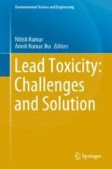Search
Search Results
-
Biosorption of lead (II) ions by lead-tolerant fungal biomass isolated from electroplating industry effluent
The increasing concerns about the toxicity of heavy metal has prompted the adoption of biosorption processes as cost-effective and eco-friendly...

-
Lead (II) removal from aqueous solution using grapevine leaves modified by polypyrrole
This study investigates lead (II) removal using grapevine leaf and polypyrrole composites. Batch adsorption tests were performed in the presence of...

-
Removal of lead(II) ions from aqueous solution using mesoporous and microporous coals: characterization, isotherm and kinetic studies
Exposure to heavy metals in water bodies is of environmental concern; hence, their removal is necessary. As-received coals obtained from two...

-
Removal of lead (II) and toluidine blue from wastewater with new magnetic Bacillus niacini nano-biosorbent
In this study, dead Bacillus niacini microorganisms were used to support the immobilization of magnetic iron nanoparticles, creating a magnetic...

-
A rapid colorimetric method for the determination of lead (II) at low concentrations in aqueous solution
Heavy metals like lead are highly toxic to human health and the environment. In this work we report a simple, reproducible and low-cost method to...

-
Biogenic gold nanoparticles of Salvia species in dyes degradation and detection of lead(II)
The present study describes synthesis of Salvia species ( S . plebeia and S. moorcroftiana ) mediated gold nanoparticles using deionized water and...

-
The Role of PbO2 in the Metal Lead Recovery from Lead Paste Via Suspension Electrolysis with Sulfuric Acid as Electrolyte
The suspension electrolysis system using sulfuric acid as the electrolyte (SE II system) provides a zero-emission strategy to recover high-purity...

-
Efficient Adsorption of Lead(II) Ions from Artificial Wastewater by Organically Tailored vs TEOS-Doped Silica Aerogels: Synthesis, Characterization and Isotherm Studies
In this study, two silica aerogels were synthesized and compared of their morphology and lead adsorptive behavior. One silica aerogel was aged with...

-
Corn cob biochar for the removal of lead ions (II): simultaneous optimization of four response variables
The study of the parameters involved in the pyrolysis process for biochar production has become extremely important for the success of its production...

-
Phosphorus and oxygen co-doped carbon particles based on almond shells with hydrothermal and microwave irradiation process for adsorption of lead (II) and cadmium (II)
In this study, the production of activated carbon based on almond shells by microwave heating with KOH activation and then the modification of...

-
Lead(II) removal from aqueous solutions and battery industry wastewater by sorption using seawater-neutralized red mud
The present study aims to investigate the feasibility of using seawater-neutralized red mud—a waste-based byproduct from bauxite refining to produce...

-
Copper(II) and lead(II) adsorption onto zinc sulfide nanoparticles effects of light, pH, time, temperature, and interferences
A ZnS nano-sorbent to remove copper(II) and lead(II) ions from aqueous solutions was prepared via a hydrothermal reaction and characterized by X-ray...

-
Synthesis of graphene oxide grafted by diazanyl groups and its application in recovery of lead from lead-acid wastewater
Heavy metal ion (HMI) in wastewater is a kind of resource that is wrongly placed. Recovery of heavy metal from lead-acid wastewater desires efficient...

-
High efficient removal of lead(II) and cadmium(II) ions from multi-component aqueous solutions using polyacrylic acid acrylonitrile talc nanocomposite
This study is interested in the removal of Pb(II), Cd(II), Co(II), Zn(II), and Sr(II) onto polyacrylic acid acrylonitrile talc P(AA-AN)-talc...

-
Magnesium ferrite-nitrogen–doped graphene oxide nanocomposite: effective adsorptive removal of lead(II) and arsenic(III)
Magnetic nanocomposites have received immense interest as adsorbents for water decontamination. This paper presents adsorptive properties of...

-
Microbial Transformations of Lead: Perspectives for Biological Removal of Lead from Soil
The most prevalent environmental contaminants, heavy metals are extremely hazardous and pose a risk to soil, water, and atmospheric resources when...
-
The Recovery of Lead from Spent Lead Acid Battery Paste by Electrodeposition in Deep Eutectic Solvent
The recovery of lead from spent lead acid battery paste (SLP) is not only related to the sustainable development of the lead industry, but also to...

-
Mercury(II) and lead(II) ions removal using a novel thiol-rich hydrogel adsorbent; PHPAm/Fe3O4@SiO2-SH polymer nanocomposite
The abundant release of toxic heavy metals into wastewater has been a serious threat to human health, aquatic environments, plants, and animals;...

-
Nanosorbent based on coprecipitation of ZnO in goethite for competitive sorption of Cd(II)-Pb(II) and Cd(II)-Pb(II)-Ni(II) systems
Amongst the various water pollutants, heavy metal ions require special attention because of their toxic nature and effects on humans and the...

-
Relation of blood lead levels and lead in gasoline: an updated systematic review
BackgroundMillions of tons of lead were added to gasoline worldwide beginning in 1922, and leaded gasoline has been a major source of population lead...

